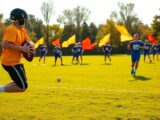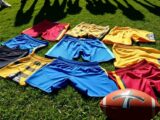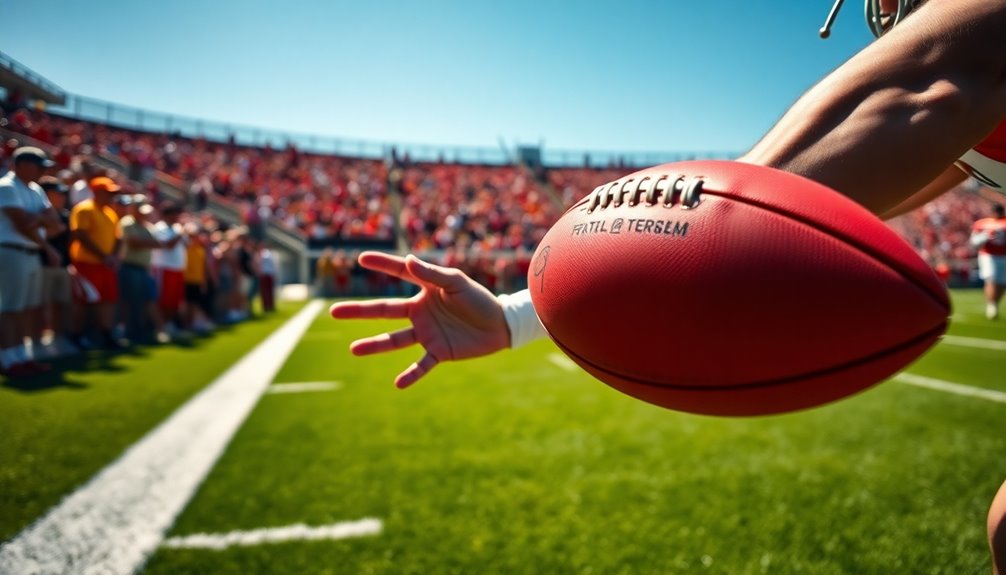
How to Catch a Football Like a Pro
January 8, 2025To catch a football like a pro, focus on the ball's trajectory and keep your eyes locked on it. Use verbal cues, like "laces," to guide your hand placement. Form a diamond shape with your fingers for high catches and keep hands relaxed for better control. Always aim for two-handed catching to enhance stability and reduce drops. Practice drills daily to build muscle memory and improve coordination. Incorporate grip strength exercises to control the ball better under pressure. Stay tuned, as mastering these techniques will elevate your game to new heights!
Importance of Visual Focus
When you step onto the field, maintaining visual focus on the football is essential for a successful catch. Your attention needs to be fully on the ball, as this greatly reduces the likelihood of drop passes.
To reinforce your focus, you can use a trigger phrase, like the "camera" analogy, which helps you visualize the ball as it approaches. This mental imagery enhances your concentration and boosts your accountability during the play. Additionally, developing core strength through targeted exercises can improve your overall stability and balance, further aiding in the catching process. Incorporating cardio training into your routine also supports your endurance, allowing you to remain focused throughout the game.
Practicing your visual focus consistently, free from distractions, leads to improved catching performance. It's not just about seeing the ball; it's about engaging with it mentally and physically.
When you're fully aware of the ball's trajectory and position, you're more likely to make the catch successfully.
Moreover, visualizing the moment you capture the ball solidifies your commitment to the task at hand. You'll find that the more you concentrate on the catch, the better your performance becomes. Additionally, integrating cardio workouts into your training regimen can further enhance your overall athleticism and focus during games.
Verbal Cues for Accountability
Visual focus sets the stage for effective catching, but complementing it with verbal cues can take your performance to the next level. Incorporating phrases like "laces" or "spaces" during practice enhances your accountability, helping you concentrate on proper hand placement when the ball arrives. When you tuck the ball, calling out "got it" reinforces your awareness, confirming the successful reception to your teammates and coaches.
Coaches play an essential role by prompting verbal cues during drills, which strengthens your focus and boosts catching consistency. By making it a habit to call out after each successful catch, you maintain concentration throughout the entire play, reducing the chances of drops. Additionally, consistent practice of technical skills will further enhance your catching ability by building muscle memory. A focus on quality training sessions helps you refine your skills and stay motivated throughout your development.
Incorporating trigger phrases related to visual focus, such as "camera," helps you mentally visualize capturing the ball, further enhancing your accountability during catching drills. Moreover, developing game intelligence through practice can significantly improve your decision-making and response time during gameplay.
These verbal cues not only improve your individual performance but also foster better communication on the field. By committing to this practice, you'll find that your catching consistency improves, making you a more reliable player in essential game moments.
Hand Placement Techniques
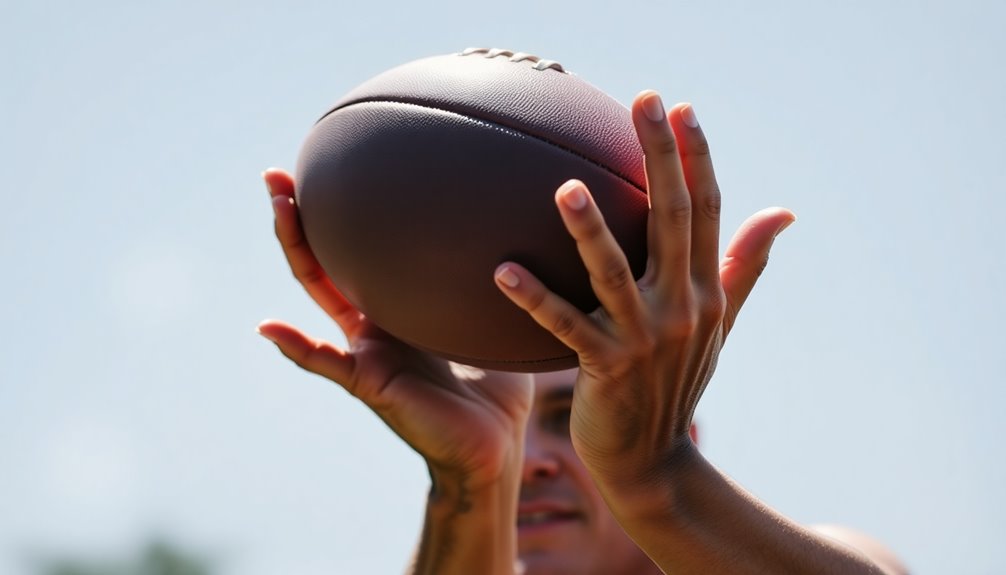
When it comes to catching a football, your hand placement is essential. For high passes, shape your hands into a diamond, while for low passes, connect your pinkies for a solid grip. Incorporating effective communication on the field can also help you anticipate where the ball will be, enhancing your catching ability. Always aim to catch the ball in the webbing of your hands to enhance your control and reduce the chances of a drop. Additionally, understanding the offside rule can improve your overall gameplay awareness, helping you anticipate passes better. Mastering the art of goalkeeper positioning can further enhance your catching skills in critical moments.
Diamond Shape for High Passes
Catching high passes requires precise hand placement, and forming a diamond shape with your hands is key to success. To do this, bring your thumbs and index fingers together, creating a secure grip above your belly button. Make sure to keep your fingers spread wide to eliminate any gaps; this prevents the ball from slipping through during the catch.
When you're ready to catch a high throw, visualize your hands as positioned on a clock, aligned from 3 o'clock to 9 o'clock. This alignment helps maintain ideal hand placement for those tricky high passes. Aim to catch the ball in the webbing of your hands rather than your palms. This technique enhances your control and greatly reduces the risk of miscatching.
Practicing this diamond shape technique consistently will sharpen your catching skills, leading to fewer dropped passes during games. With dedication, you'll find that your confidence grows, and you'll become a reliable target on the field.
Pinky Connection for Low Passes
Mastering the pinky connection technique is vital for successfully handling low passes. When you anticipate a low throw, guarantee your pinky fingers are connected. This connection creates a secure grip, preventing the ball from slipping through your hands.
Position your hands in a diamond shape for passes at or above your belly button, but for low throws, focus on bringing your hands closer together. Keep your fingers tight with no gaps, which reduces the risk of miscatching. A firm grip is essential; think of your pinky fingers as a safety net for the ball.
Instead of catching the ball in your palms, concentrate on securing it in the webbing of your hands. This technique enhances control and absorption, allowing you to manage those tricky low passes effectively.
Practicing this pinky connection consistently will noticeably increase your catching proficiency. The more you refine this technique, the more reliable you'll become at handling low throws, guaranteeing you stay in the game and make those essential catches when it counts.
Webbing Catching Technique
To effectively secure a football, you need to focus on the webbing of your hands. When catching high passes, position your hands to form a diamond shape, bringing your thumbs together while keeping your fingers spread. For low passes, connect your pinky fingers to create a secure pocket. Proper hand positioning is essential; keep your hands aligned between 3 and 9 o'clock to prevent gaps that could lead to miscatching.
Always aim to catch the ball in the webbing of your hands rather than your palms. This technique gives you better control and reduces the chances of the ball slipping through. Remember to employ "soft hands" during the catch, allowing the webbing to absorb the impact of the ball. This not only results in quieter receptions but also enhances your handling.
Consistent practice of these hand placement techniques will greatly improve your grip strength. Stronger grip strength means more reliable ball reception and greater control while playing.
Understanding Soft Hands
Soft hands are essential for successfully receiving a football, as they allow you to absorb the impact of the ball while enhancing control. This technique involves using a gentle grip to catch the ball, which reduces noise and increases your grip stability.
To achieve soft hands, focus on proper hand placement; catch the ball in the webbing of your hands rather than the palms. This not only improves your control but also helps prevent the ball from slipping away. Incorporating cardio workouts into your training can further improve your overall athleticism, enabling you to be more agile when catching the ball.
When catching high throws, maintain a diamond shape with your hands. For lower throws, connect your pinky fingers to create a secure base. Practicing soft hands consistently will lead to better catch rates and minimize dropped passes. Remember, the goal is to absorb the ball rather than push it away. Additionally, incorporating speed and agility drills into your training can enhance your overall coordination, benefiting your catching ability.
To further develop your soft hands, incorporate grip-strengthening exercises like fingertip push-ups into your routine. This will enhance your ability to make reliable catches during gameplay. Additionally, the evolution of various ball games, including ancient civilizations' ball games, highlights the importance of skill and technique in sports like soccer and football.
Over-the-Shoulder Catch Techniques
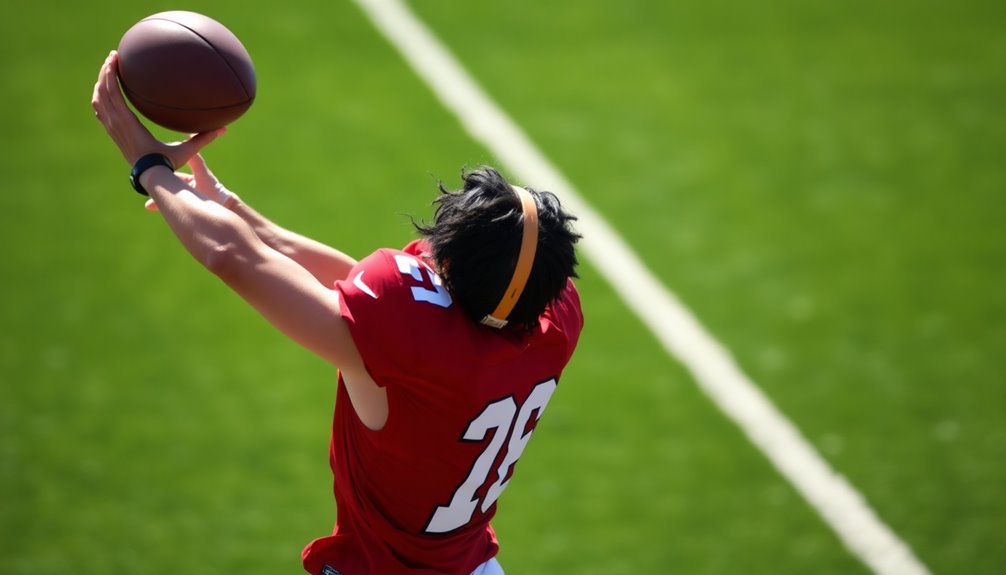
When it comes to making an over-the-shoulder catch, your focus on the ball is essential. As you track those deep passes, trust your eyes to follow the trajectory closely. This will help you anticipate the catch point and position yourself effectively.
To enhance your chances, utilize "late hands." This technique involves waiting until the ball is nearly at your catch point before raising your hands. By doing so, you keep your catching motion concealed from defenders, adding an element of surprise.
Aim to catch the ball at chest level for better control and stability. This positioning not only secures the catch but also helps you maintain your balance amid defensive pressure. Avoid the urge to reach for the ball too early; patience is key. Proper technique during catches can help minimize the risk of injury, similar to the importance of proper form in slide tackling.
Regularly practicing drills specifically designed for over-the-shoulder catches will also build your muscle memory. The more you rehearse, the more automatic your response will be during games. Additionally, being aware of defensive versatility can help you anticipate how defenders might react, allowing you to adjust your catching technique accordingly. Understanding the importance of effective player selection can also help you identify the right techniques that suit your style.
Incorporating these techniques will elevate your game and make you a more reliable receiver. So, stay focused, trust your instincts, and practice consistently to master the over-the-shoulder catch.
The Role of Grip Strength
Grip strength is essential for catching a football effectively, as it helps you control the ball and absorb catches instead of pushing them away.
By incorporating grip-strengthening exercises into your routine, you can greatly boost your catching ability and reduce the risk of drops.
A strong grip not only enhances your performance on the field but also improves your overall athletic skills.
Importance of Grip Strength
Many athletes might underestimate the importance of grip strength in catching a football, but it plays a critical role in your ability to control the ball. A strong grip enhances your catching ability and helps you secure the football, reducing the likelihood of drops or fumbles during plays.
Consider these key benefits of grip strength:
- Improved Control: A strong grip allows you to manage the ball better, especially in challenging conditions.
- Injury Prevention: Strong grip strength absorbs impacts, minimizing the risk of injuries during physical activities.
- Enhanced Football Handling: For positions that require frequent ball handling, a solid grip guarantees you can maintain possession under pressure.
- Overall Athletic Performance: Consistent grip-strength training boosts your performance, enabling you to play at higher levels.
Incorporating grip-strengthening exercises into your routine, like fingertip push-ups and specialized drills, can lead to significant improvements in your overall catching ability.
Strengthening your grip is vital for any aspiring football player looking to excel on the field and secure the ball effectively during the game.
Exercises for Strong Grip
To enhance your grip strength, incorporating targeted exercises into your training routine is essential. Strong grip strength is important for catching and controlling the football, as it reduces the risk of dropping passes and improves your performance on the field.
Start with fingertip push-ups; they'll not only build hand strength but also improve your stability. You can also use resistance bands. Simply grip the band with both hands and stretch it outwards to engage your fingers and wrists.
Another effective exercise is the plate pinch; hold weight plates between your fingers for as long as you can. Regular practice and gradually increasing the difficulty of these exercises will lead to noticeable improvements.
Incorporating these grip-strengthening workouts into your daily routine is critical for positions that require precise ball handling. Remember, grip strength not only aids in catching but also reduces the risk of injury during physical activities, allowing you to perform at your best.
Monitor your performance and adjust your grip training as needed. By focusing on these exercises, you'll foster continual development and make grip strength an essential part of your all-encompassing athletic training program.
Impact on Catching Ability
Catching a football effectively hinges on your grip strength, as it directly influences your ability to control the ball under pressure. A strong grip not only reduces the risk of drops during intense play but also enhances your overall catching ability.
Here's how grip strength impacts your performance:
- It improves hand coordination, making it easier to track and catch the ball.
- Stronger grip strength allows you to maintain control during physical contact with defenders.
- Regular grip-strengthening exercises boost athletic performance, translating into better catches.
- Enhanced grip contributes to injury prevention by enabling you to withstand hits while securing the ball.
Training focused on grip strength can lead to noticeable improvements in your catching ability within just a few weeks.
By incorporating exercises like fingertip push-ups, you'll build the muscle needed for more consistent receptions.
Remember, grip strength isn't just about power; it's about control and stability. As you enhance your grip, you'll not only catch more passes but also reduce your chances of injury, allowing you to play confidently on the field.
Grip Strength Training Exercises
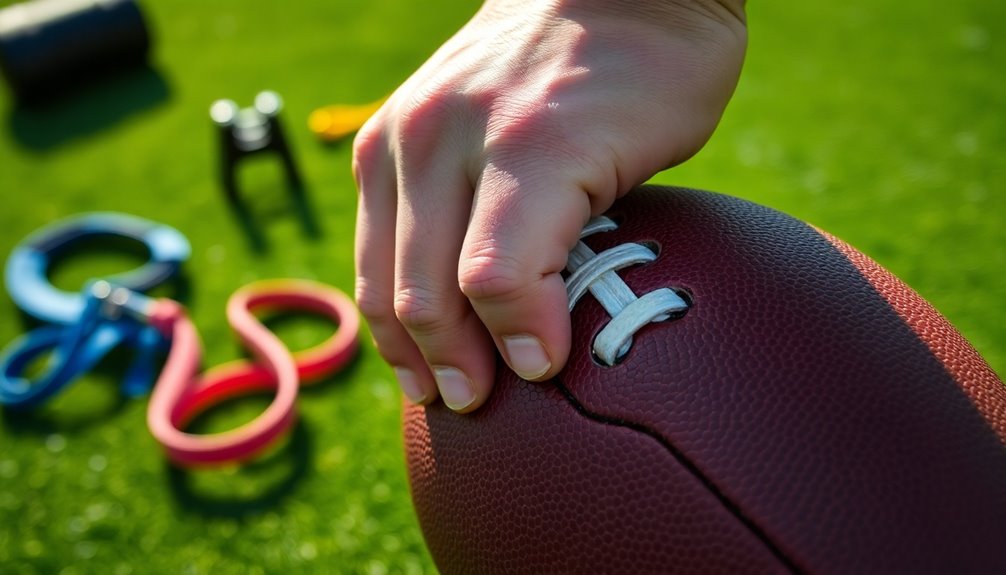
Enhancing grip strength is essential for successfully catching a football, as it directly impacts your ability to secure the ball during play. One effective exercise is fingertip push-ups; aim for 8-10 reps for 3-4 sets. This not only improves grip strength but also boosts your upper body stability.
You can also use grip trainers or hand grippers, gradually increasing resistance to build the muscle needed to maintain a strong hold on the football. Engaging in rock climbing or similar activities can greatly enhance grip strength and coordination over time.
Additionally, incorporate plate pinches into your routine by holding weight plates together with your fingers for 30-60 seconds. This exercise hones finger strength, which is essential for better ball control.
Don't forget to perform wrist curls with dumbbells to target your forearm muscles, further enhancing grip strength important for securing the ball during high-pressure scenarios.
Daily Drills for Improvement
Regularly practicing specific drills can greatly boost your football catching skills. Incorporate these exercises into your daily routine to see significant improvements in your performance.
- Fingertip push-ups: Perform 3-4 sets of 8-10 reps to strengthen your grip and enhance upper body control, both essential for catching the football.
- Hand-eye coordination drill: Use two tennis balls and a wall. Catch one ball with one hand after hearing the bounce, aiming for 20-30 reps with each hand to improve reaction time.
- Over-the-shoulder catching drill: Bounce a tennis ball off the wall and track it after the bounce. Aim for 20-30 successful catches with each hand to develop muscle memory for deep passes.
- Grip-strengthening exercises: Include a variety of these exercises daily, progressively increasing the difficulty to enhance hand strength and improve your overall catching ability.
Additionally, focus on the "camera" analogy during practice. This technique will help reinforce your visual focus on the ball, reducing drop passes and increasing your accountability in catching.
Implement these drills consistently, and you'll notice a marked improvement in your skills on the field.
Fingertip Push-Up Benefits
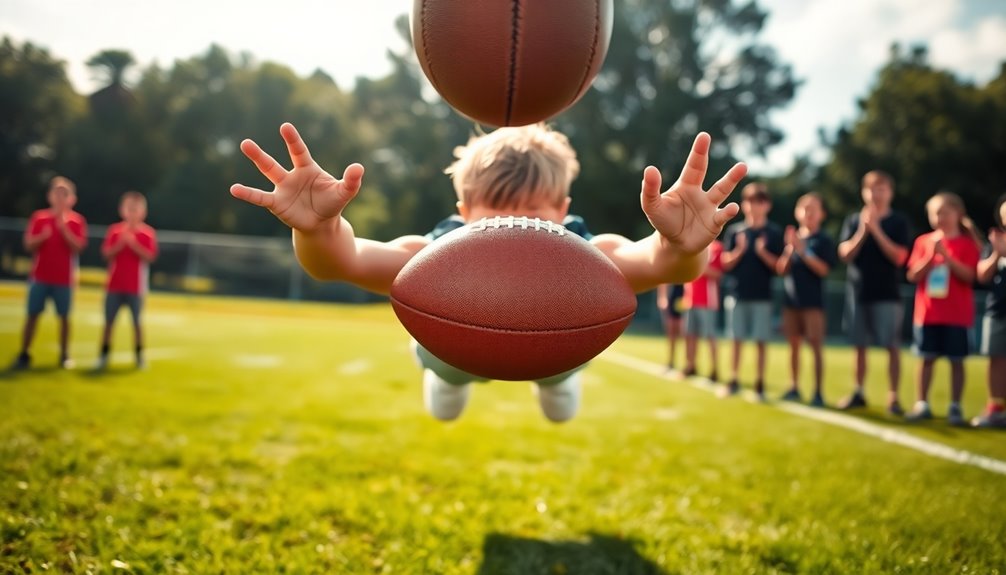
Fingertip push-ups are a game-changer for your grip strength, which is essential when catching a football.
By strengthening your upper body stability, you'll gain better control during catches, reducing the chances of drop passes.
Plus, this exercise engages your core and shoulders, enhancing your overall balance on the field.
Enhanced Grip Strength
To improve your grip strength for catching a football, incorporating fingertip push-ups into your routine can make a significant difference. This exercise specifically targets the muscles in your hands and forearms, leading to a stronger grip essential for catching and controlling the football.
Consider these benefits of fingertip push-ups:
- Enhanced grip strength: You'll develop a firmer grasp, making it easier to hold onto the ball.
- Soft hands: This technique promotes better absorption when making catches, reducing the chances of dropping the ball.
- Injury prevention: Strengthening your grip through fingertip push-ups can minimize your risk of injuries during physical activities.
- Progressive challenge: As you improve, you can increase the difficulty by adding weight or performing them on an unstable surface.
Aim for 8-10 repetitions per set for 3-4 sets, and you'll notice improved hand stability and dexterity over time.
Improved Upper Body Stability
Incorporating fingertip push-ups into your workout not only boosts grip strength but also enhances upper body stability, which is vital for catching a football effectively. When you perform these push-ups, you engage the muscles in your shoulders, chest, and core, which are fundamental for maintaining balance during dynamic movements on the field.
Aim for 8-10 fingertip push-ups per set, and do 3-4 sets to see significant improvements in your grip strength. This strength translates directly to better control of the football during catches. Additionally, fingertip push-ups promote proper hand placement techniques by requiring you to be mindful of your finger positioning and pressure distribution, further benefiting your catching skills.
Regularly including fingertip push-ups in your training routine can lead to noticeable improvements in overall athletic performance, especially for positions that demand strong hand strength and stability.
Plus, as your grip strength increases, the risk of injury during physical activities decreases, allowing you to perform at your best during games. Embrace fingertip push-ups, and watch your upper body stability soar!
Increased Catching Control
Strengthening your grip through fingertip push-ups can greatly enhance your catching control on the field. These push-ups not only build grip strength but also develop the upper body muscles needed for maintaining control when catching a football. Incorporating them into your training routine can make a substantial difference in your performance.
Here are some benefits of fingertip push-ups:
- Enhanced grip strength: Stronger fingers lead to better control of the ball.
- Soft hands: You'll develop the ability to absorb and secure catches effectively.
- Reduced drop passes: Improved stability from strengthened muscles minimizes errors during games.
- Increased confidence: As your grip strength improves, you'll feel more assured while executing catching techniques under pressure.
Aim for 8-10 reps per set, with 3-4 sets in your routine. This practice not only bolsters your hand strength and stability but also helps you build the muscle memory essential for consistent catching techniques.
Hand-Eye Coordination Drill
How can you elevate your catching skills to the next level? Try the Hand-Eye Coordination Drill, a simple yet effective way to sharpen your reaction time and improve your hand-eye coordination.
For this drill, you'll need two tennis balls and a wall. Start by standing about 5-6 yards away from the wall. Throw one tennis ball against the wall and close your eyes. Focus on listening carefully for the sound of the ball bouncing back. When you hear it, react quickly and catch the ball one-handed. Complete 20-30 repetitions with each hand.
This drill challenges your ability to track and catch the ball using auditory cues, which is essential in real game situations. It forces you to rely on sound and timing, honing those crucial catching skills.
As you practice consistently, you'll develop muscle memory, allowing your body to react instinctively under pressure.
Incorporating the Hand-Eye Coordination Drill into your routine can lead to significant improvements in your overall performance. So, grab those tennis balls and start practicing—your catching game will thank you!
Over-the-Shoulder Catching Drill
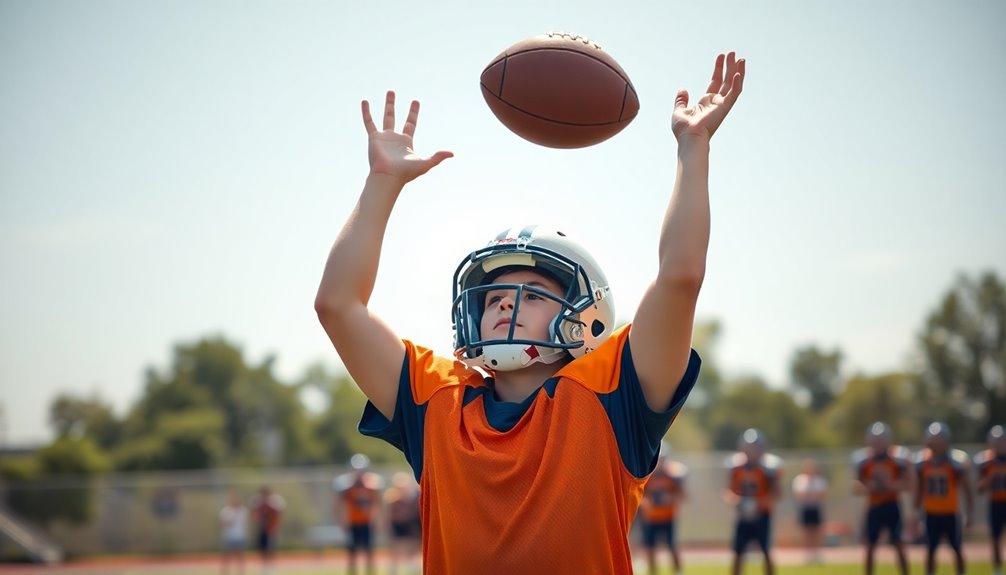
One effective way to elevate your catching skills is by practicing the Over-the-Shoulder Catching Drill. Start by standing 0.5-1 yard away from a wall and bounce a tennis ball off it. This simulates a deep pass and helps you improve your catching technique.
As you perform the drill, focus on tracking the ball with your eyes after you hear it hit the wall. This enhances your visual awareness and reaction time, essential for catching in game situations.
Begin without looking up initially; this builds trust in your tracking ability and develops muscle memory. Aim to complete 20-30 reps with each hand to boost coordination and guarantee consistent catching from either side.
Here's what to keep in mind:
- Stand 0.5-1 yard from a wall.
- Track the ball after it bounces.
- Practice using "late hands" for better control.
- Focus on catching with both hands.
Developing Muscle Memory
To catch a football with consistency and confidence, developing muscle memory is crucial. This involves practicing proper hand placement and techniques repeatedly, which reinforces your body's ability to respond correctly during games. Engaging in specific drills, like the Over-the-Shoulder Catching Drill, helps create automatic responses by allowing you to practice the motion until it becomes second nature.
Incorporating visual focus techniques can greatly aid in solidifying muscle memory. Visualizing the ball and using verbal cues align your mental and physical actions when catching. Regular grip-strengthening exercises, such as Fingertip Push-Ups, enhance your hand control, which is essential for executing catches precisely.
Moreover, drills designed for improving hand-eye coordination, like the Hand-Eye Coordination Drill, further embed the catching motion into your muscle memory. These drills train your body to react instinctively to varying ball trajectories, making you a more effective receiver.
Consistency in Practice
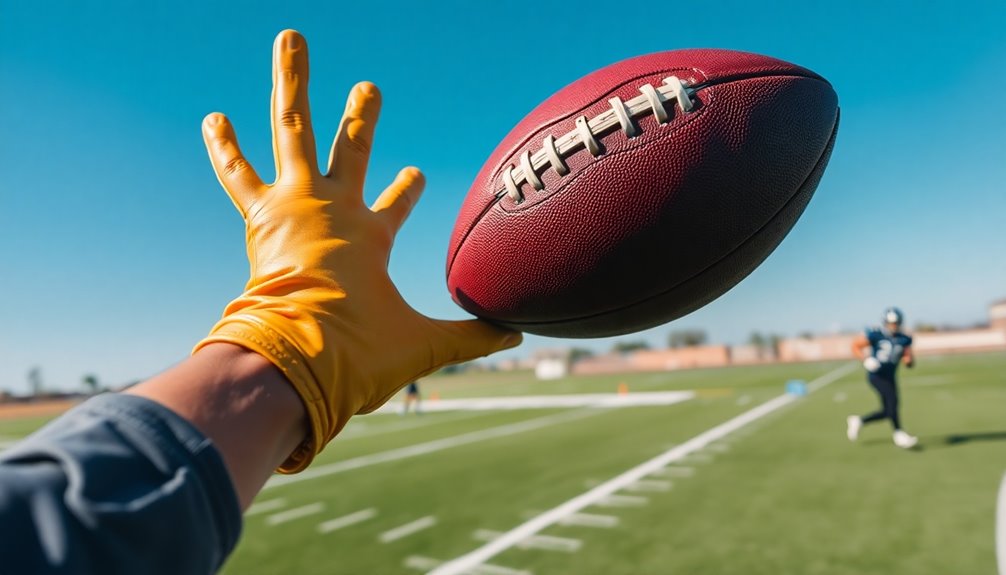
Establishing a routine for consistent practice is essential for mastering the art of catching a football. By focusing on key elements during your training, you can markedly improve your performance and reduce drop passes.
Here are some effective strategies to incorporate into your practice sessions:
- Visual Focus: Concentrate on the ball as it approaches, helping you track it more accurately.
- Verbal Cues: Use trigger phrases to reinforce accountability, making catching feel more instinctive.
- Grip Strength Drills: Regularly practice techniques that enhance hand placement and grip for reliable catching.
- Over-the-Shoulder Catches: Focus on "late hands" to develop muscle memory, ensuring catches become automatic in high-pressure situations.
Conclusion
In your journey to catch a football like a pro, remember to focus your eyes, listen for verbal cues, and position your hands correctly. Embrace soft hands, practice over-the-shoulder techniques, and engage in hand-eye coordination drills. Develop muscle memory through consistent practice, and soon you'll find yourself catching with confidence, catching with precision, and catching like the best. With dedication and persistence, you'll elevate your game and impress everyone on the field.

